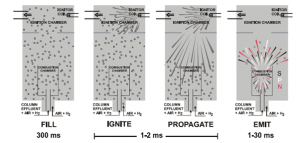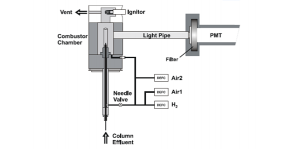Pulsed Flame Photometric Detector (PFPD)
The Pulsed Flame Photometric Detector (PFPD) has 2 modes:
- Phosphorus/Sulphur mode
- Nitrogen mode (can be upgraded to by replacing the photomultiplier tube (PMT) housing and filter provided in the upgrade kit)
P/S Mode:
Its functioning relies on the principle of flame photometry, which entails measuring the intensity of emitted light from excited atoms or ions within a flame. The step-by-step operational principle, along with an illustrative diagram of the detector (Figure 1), aids in comprehending the entire process.

Figure 1. Shows the stages of PFPD combustion
The procedure initiates with the introduction of the sample into the GC, where it undergoes separation into individual components while traversing the chromatographic column. Exiting the column, the separated components enter the combustion chamber of the PFPD, where a pulsed flame is generated, typically fueled by a hydrogen and air mixture. Sulfur- or phosphorus-containing compounds from the sample undergo combustion in the flame, producing sulfur dioxide (SO₂) or phosphorus pentoxide (P₄O₁₀), respectively.

Figure 2. Shows the flow path of gases entering and exiting the PFPD
Subsequently, the combustion products (SO₂ or P₄O₁₀) are excited within the flame, leading to the emission of characteristic light. Sulfur emits light in the ultraviolet region, and phosphorus emits light in the visible region. The emitted light passes through optical filters, isolating specific wavelengths corresponding to sulfur or phosphorus emissions. Directed to the Photo Multiplier Tube (PMT), the filtered light is converted into an electrical signal.
The electrical signals undergo amplification and processing, generating a chromatogram. Peaks in the chromatogram correspond to concentrations of sulfur- or phosphorus-containing compounds in the original sample. Renowned for its sensitivity and selectivity in detecting sulfur and phosphorus, the PFPD finds utility in diverse applications, including environmental monitoring, petrochemical analysis, and various other fields where precise analysis of these elements is crucial.
N Mode
Nitrogen mode is based upon combustion of nitrogen-containing compounds to form NO.
NO then reacts with the hydrogen atoms remaining in the combustor after the flame is extinguished to form HNO*, an electronically excited molecule which emits light in the 700-800 nm range of the near infrared. Because these emission wavelengths are beyond the range of the photomultiplier tube (PMT) used in the standard Pulsed Flame Photometric Detector (PFPD), the Nitrogen mode requires a new red-sensitive photomultiplier and PMT holder hardware, along with an appropriate dark red coloured glass filter.
Because N mode is based on complete combustion of the sample molecule to form HNO*, the PFPD response is much less dependent on the chemical nature of the sample than is the NPD response, which depends on the presence of a C N bond in the molecule. Thus even inorganic nitrogen compounds such as ammonia, hydrazine and nitrogen oxides are detectable by the N mode PFPD, whereas these compounds give no response on the NPD.
The only nitrogen compound known to give no useful response on the PFPD is molecular nitrogen, N2. Compounds such as nitro-glycerine and other nitrate esters, nitroaromatics and nitroso compounds give a somewhat enhanced response when compared to more reduced nitrogen compounds, but the enhancement amounts to only approximately 20 %, so for most purposes the N mode PFPD can be considered to give a uniform response to all nitrogen compounds, as it does for sulphur and phosphorus compounds.
Uniformity of response may be enhanced by increasing the oxygen flow into the combustor, at the cost of some reduction in sensitivity.
Oxidation of nitrogen requires a hotter flame than either phosphorus or sulphur. This is reflected in the following table of recommended flame gas flow rates. In general, the nitrogen mode requires a more air rich flame and suffers a larger reduction in sensitivity as carrier flow rate increases. Use of the 3 mm combustor provides best detectivity.
Consumables and Spares
Spares:
- Combustor Sulfur Quartz 2mm (392517600)
- Combustor Sulfur Holder 2 mm (392517800)
- Combustor Phosphorous Quartz 3 mm (392517700)
- Combustor Phosphorous Holder 3mm (392517901)
- Combustor Holder Seal (392513800)
- PFPD Tower Assy P, S, N Modes (392513301)
Consumables:
| 41312148 | 15% GRAPHITE/85% VESPEL FERRULE 1/16″ WITH 0.4MM HOLE PK/10 |
| 41312149 | 15% GRAPHITE/85% VESPEL FERRULE 1/16″ WITH 0.5MM HOLE PK/10 |
| 41312150 | 15% GRAPHITE/85% VESPEL FERRULE 1/16″ WITH 0.8MM HOLE PK/10 |
| 41312153 | 15% GRAPHITE/85% VESPEL FERRULE 1/16″ NO HOLE PK/10 |
Order Today
For more information or to place an order, please get in touch.
